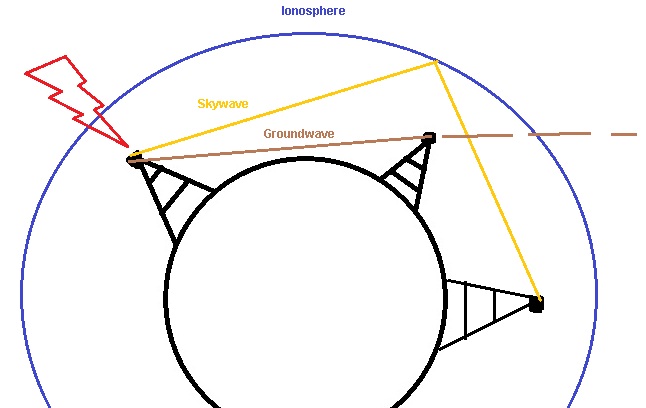
Radio Wave Propagation
NOTICE TO SWLD
READERS:
This article is a very basic introduction to the topic of radio wave
propagation - targeted toward new shortwave listeners.
To fully understand all the
various types and mechanisms of sky wave propagation you are advised to
read further.
There are 1000's of books and articles on this subject containing more
much more detailed and technical information.
If this article interests you please see our
links page for access to
some of
these expanded resources.
Radio wave propagation
explains 'how a radio wave
travels from a transmitter to a receiver'.
In terms of shortwave radio - when someone is referring to propagation (although not technically the correct
use of the terminology) they are generally
referring to the radio signal's ability to be received in a location
which is a long distance from the transmitter.
(e.g. Good sky wave propagation allows Radio New Zealand on 9615 KHz to be
easily received in Sydney, Australia - over 2000 KM's away.)
TOPICS OF DISCUSSION:
-
-
Ground Wave
-
Sky Wave
-
Radio Waves
Radio waves will normally travel in straight lines.
Sometimes, however, the environment around us can cause those radio
waves to bounce or bend in a way which, in some cases, benefits us as
short wave users - because it causes those waves to bounce around the
horizon and travel much further distances than a normal straight line
(called
'line of sight') transmission should.
There are two general classes of radio wave propagation - Ground Wave and Sky Wave.
Ground wave: A radio signal
travelling directly from one antenna to
another (line of
sight).
The effective distance of transmission is determined by the height of
the transmit and receive antennas, and by any obstacles/obstructions
(such as mountains) in between them. An example of groundwave is your
mobile phone and the phone tower. Imagine the radio wave travelling
directly to the tower - if a mountain gets in the way your signal is
blocked!
Shortwave broadcasts (except NVIS - explained in another lesson) are not generally designed to be received by ground
wave, since those distances are only around 50-300 KM.
In most cases such distances may be better covered by the use of MF,VHF, or UHF systems
(conventional AM / FM broadcast).
Sky wave:
Describes a radio signal which has been refracted
(or bent) by a part of the atmosphere - effectively sending it back down to earth,
usually past the
range of a 'line of sight'
(groundwave) receiving antenna.
This atmospheric phenomenon, acting as something of a mirror to radio
waves, is what allows
short wave signals to be received at long distances.
Sometimes this is
signal propagation is referred to as 'skip'.
The part of the atmosphere acting as a mirror is called the
ionosphere.

The Ionosphere - How Sky Wave Propagation Works
Sky waves are refracted (or bent) by a part of the
atmosphere called the Ionosphere
(approx
400 Km's above earth surface).
The Ionosphere is comprised of several layers in the earths upper atmosphere which become
electrically charged by solar radiation from the sun.
The Ionosphere's electromagnetic charge alters depending on the Sun.
This means that the time of day, the season, and the
solar
sunspot cycle (solar 11 year magnetic strength cycle) affect the
composition of the ionosphere and can reduce or increase the
effectiveness of shortwave radio wave propagation.
As the electromagnetic charges in the Ionosphere change, the
frequencies which can be refracted by the Ionosphere change- different
frequencies are refracted better at different day times and seasons.
Generally the Ionosphere will only refract the HF bands (3-30 MHz), normally the current extent of refractive frequencies is called the MUF 'maximum usable frequency' and changes during the day and season. - This is measured by the 'T Index' - See links.
The MUF is the maximum usable frequency by the
Ionosphere.
HF networks use daytime, night time, summer/winter, and H24 operations
to exploit this change in MUF.
For example Australian Defence provides 9 MHz for H24, 22 MHz for day,
and 5 MHz for night to follow the Ionosphere's daily solar cycle.
You will notice some networks will provide for summer and winter frequencies - this is because of how much the Sun charges the Ionosphere during periods of low or intense solar activity.
Approximate guide to frequency bands and ranges - (For 100 watt commercial services)- Source: ACMA
| Approximate distance | Day | Night |
|---|---|---|
| Less than 300 km | 3–4 MHz | 2–4 MHz |
| Between 300 km and 750 km | 4–6 MHz | 3–7 MHz |
| Between 750 km and 1,500 km | 5–9 MHz | 6–10 MHz |
| Between 1,500 km and 2,500 km | 8–12 MHz | 7–11 MHz |
| Between 2,500 km and 5,000 km | 10–18 MHz | 8–15 MHz |
Content updated 14/9/2012
